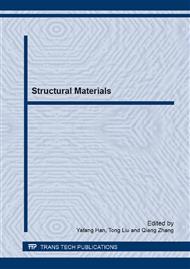[1]
J.M. Cai, X. Xu, C.X. Cao, J.M. Ma, Thermal stability of TG6 titanium alloy and its partial resumption at high temperature, Rare Met. Mate. Eng. 39(2010) 1893-1898.
DOI: 10.1016/s1875-5372(10)60133-6
Google Scholar
[2]
Y.F. Han, W.D. Zeng, Y.L. Qi, Y.Q. Zhao, The influence of thermomechanical processing on microstructural evolution of Ti600 titanium alloy, Mater. Sci. Eng A. 528 (2001) 8410-8416.
DOI: 10.1016/j.msea.2011.08.007
Google Scholar
[3]
S.Z. Zhang, M.M. Li, R. Yang, Mechanism and kinetics of carbide dissolution in near alpha Ti-5.6Al-4.8Sn-2Zr-1Mo-0.35Si-0.7Nb titanium alloy, Mater Charact. 62 (2011) 1151-1157.
DOI: 10.1016/j.matchar.2011.10.001
Google Scholar
[4]
W.F. Cui, C.M. Liu, L. Zhou, G.Z. Luo, Characteristics of microstructures and second-phase particles in Y-bearing Ti-1100 alloy, Mater. Sci. Eng A. 323 (2002) 192-197.
DOI: 10.1016/s0921-5093(01)01362-4
Google Scholar
[5]
R.C. Atwood, P.D. Lee, R.V. Curtis, D.M. Maijer, Modeling the investment casting of a titanium crown, Dent Mater. 23 (2007) 60-70.
DOI: 10.1016/j.dental.2005.12.001
Google Scholar
[6]
J. Mi, R.A. Harding, M. Wickins, J. Campell, Entrained oxide films in Ti-Al castings, Intermetallics. 11 (2003) 377-385.
DOI: 10.1016/s0966-9795(03)00006-2
Google Scholar
[7]
J. Barbosa, C.S. Ribeiro, A.C. Monteiro, Influence of superheating on casting of γ-TiAl, Intermetallics. 15 (2007) 945-955.
DOI: 10.1016/j.intermet.2006.11.004
Google Scholar
[8]
T.T. Sun, M. J. C. H. Li, X. G. Lu, W.D. Liu, Modification of CaO refractory for melting titanium alloys and its hydration resistance, Adv. Mater. Res. 177 (2011) 502-505.
DOI: 10.4028/www.scientific.net/amr.177.502
Google Scholar
[9]
F. Gomes, J. Barbosa, C.S. Ribeiro, Induction melting of γ-TiAl in CaO crucibles, Intermetallics. 16 (2008) 1292-1297.
DOI: 10.1016/j.intermet.2008.08.008
Google Scholar
[10]
R.L. Saha, T.K. Nandy, R.D.K. Misra, K.T. Jacob, Evaluation of the reactivity of titanium with mould materials during casting, Bull. Mater. Sci. 12 (1989) 481-493.
DOI: 10.1007/bf02744918
Google Scholar
[11]
D. Weinem, J. Kumpfert, M. Peters, W.A. Kaysser, Processing window of near-α-titanium alloy Timetal-1100 to produce a fine-grained β-structure, Mater. Sci. Eng A. 206 (1996) 55-62.
DOI: 10.1016/0921-5093(95)09987-5
Google Scholar
[12]
D.H. Lee, S.W. Nam, S.J. Choe, Effect of microstructure and relaxation behavior on the high temperature low cycle fatigue of near-α-Ti-1100, Mater. Sci. Eng A. 291 (2000) 60-67.
DOI: 10.1016/s0921-5093(00)00974-6
Google Scholar
[13]
B.K. Parida, T. Nicholas, Elevated temperature fatigue crack growth behavior of Ti-1100, Fatigue Eng. Mater. Struct. 17 (1994) 551-561.
DOI: 10.1111/j.1460-2695.1994.tb00254.x
Google Scholar
[14]
J.P. Cui, M.L. Sui, Y.Y. Cui, D.X. Li, Ductile TiAl alloy with a Widmanstatten lamellar structure formed by rapid heating, J. Mater. Res. 23 (2008) 949-953.
DOI: 10.1557/jmr.2008.0138
Google Scholar
[15]
Y.W. Sui, B.S. Li, A.H. Liu, H. Nan, J.J. Guo, H.Z. Fu, Microstructures and hardness of Ti-6Al-4V staging castings under centrifugal field, Trans. Nonferrous Met. Soc. China. 18 (2008) 291-296.
DOI: 10.1016/s1003-6326(08)60051-5
Google Scholar


